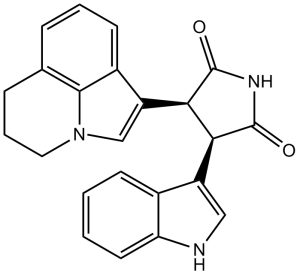This product is for research use only, not for human use. We do not sell to patients.

| Size | Price | Stock |
|---|---|---|
| 500mg | $820 | Check With Us |
| 1g | $1350 | Check With Us |
| 5g | $3420 | Check With Us |
Cat #: V0604 CAS #: 905854-02-6 Purity ≥ 98%
Description: Tivantinib (formerly also known as ARQ-197; ARQ197), an experimental drug developed by by Arqule, Inc, is the first non-ATP-competitive, orally bioavailable and selective small molecule c-Met inhibitor with potential antineoplastic activity.
Publications Citing InvivoChem Products
Product Promise

- Physicochemical and Storage Information
- Protocol
- Related Biological Data
- Stock Solution Preparation
- Quality Control Documentation
| Molecular Weight (MW) | 369.42 |
|---|---|
| Molecular Formula | C23H19N3O2 |
| CAS No. | 905854-02-6 |
| Storage | -20℃ for 3 years in powder formr |
| -80℃ for 2 years in solvent | |
| Solubility In Vitro | DMSO: 73 mg/mL (197.6 mM)r |
| Water: <1 mg/mLr | |
| Ethanol: <1 mg/mL | |
| Solubility In Vivo | |
| SMILES Code | O=C([C@@H](C1=CN2CCCC3=C2C1=CC=C3)[C@@H]4C5=CNC6=C5C=CC=C6)NC4=O |
| Synonyms | Tivantinib; ARQ-197; ARQ 197; ARQ197; |
| Protocol | In Vitro | Tivantinib (ARQ 197) selectively inhibits c-Met activity in cell-free and cell-based assays. c-Met-expressing cancer cell lines treated with Tivantinib display either a dose-dependent loss of proliferative capacity or caspase-dependent apoptosis that positively correlates with either ligand-dependent c-Met activity or constitutively active c-Met. To examine the biochemical mode of inhibition of Tivantinib, kinetic analyses are done using recombinant human c-Met in a filtermat-based assay. The Km of ATP is 50.5±2.2 μM, which is similar to the Km value of ATP. In these kinetic studies, Tivantinib inhibits human recombinant c-Met with a calculated inhibitory constant (Ki) of ~355 nM. In vitro exposure to Tivantinib inhibits constitutive c-Met phosphorylation in HT29 and MKN-45 cells, and HGF-induced c-Met phosphorylation in MDA-MB-231 and NCI-H441 cells with an IC50 of 100 to 300 nM. |
|---|---|---|
| In Vivo | Pharmacodynamically, the phosphorylation of c-Met in human colon xenograft tumors (HT29) is strongly inhibited by Tivantinib (ARQ 197), as assessed by a dramatic reduction of c-Met autophosphorylation 24 hours after a single oral dose of 200 mg/kg of Tivantinib. This same dosage in mice shows that tumor xenografts are exposed to sustained plasma levels of Tivantinib, consistent with the observed pharmacodynamic inhibition of c-Met phosphorylation and inhibition of proliferation of c-Met harboring cancer cell lines. A Cmax of 5.73 μg/mL (13 μM), an area under the concentration-time curve of 12.1 μg/mL h, and a t1/2 of 2.4 hours are measured. Plasma levels of Tivantinib 10 hours after dosing are determined to be 1.3 μM, >3-fold above the biochemical inhibitory constant of Tivantinib for c-Met. |
| Solvent volume to be added | Mass (the weight of a compound) | |||
|---|---|---|---|---|
| Mother liquor concentration | 1mg | 5mg | 10mg | 20mg |
| 1mM | 2.7069 mL | 13.5347 mL | 27.0695 mL | 54.1389 mL |
| 5mM | 0.5414 mL | 2.7069 mL | 5.4139 mL | 10.8278 mL |
| 10mM | 0.2707 mL | 1.3535 mL | 2.7069 mL | 5.4139 mL |
| 20mM | 0.1353 mL | 0.6767 mL | 1.3535 mL | 2.7069 mL |
This equation is commonly abbreviated as: C1 V1 = C2 V2
- (1) Please be sure that the solution is clear before the addition of next solvent. Dissolution methods like vortex, ultrasound or warming and heat may be used to aid dissolving.
- (2) Be sure to add the solvent(s) in order.




































